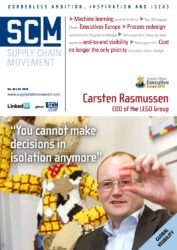Stocking index encourages inventory discussions

Inventory planners have struggled with stock levels more than ever over the past year. How can they make the right choices? In a recent episode of Webinar Wednesday, inventory experts from Slimstock shifted the attention to tactical issues. The stocking index can support decisions about which items to hold in stock, for example.
By Marcel te Lindert
When the topic of inventory comes up in strategic discussions, it often revolves around the total value of the stock. “But the matter of what you actually have in stock is more important than how much stock you have,” said Richard Evans, Managing Director UK & Nordics at Slimstock, during the webinar. His colleague Jan Kraaijeveld, Sales & Business Development Manager at Slimstock in the Netherlands, agreed: “In fact, it doesn’t matter if you have 5, 10 or 100 million euros worth of stock, as long as that stock is sold and contributes to profitability. But when we visit companies and sit down with inventory planners, we almost always see them struggling with the daily orders. This is caused by the failure to adequately translate the strategic objectives into operational ones and answer the right questions: Which items should and shouldn’t you hold in stock? And how should you deal with items in the various life cycle phases? We need to focus more on these kinds of tactical issues rather than on day-to-day operations.”
Stocking index
Portfolio management is all about these kinds of issues. It starts with the composition of the total portfolio: ‘Which items do I want to sell?’. Then come the follow-up questions: ‘Which items should I hold in stock myself?’, ‘Where should the stock be held?’, ‘How high should the stock level be?’ and ‘What is the stock strategy: push or pull?’. Kraaijeveld: “We mustn’t forget other important questions relating to inventory management, such as who is responsible for which stock? And which KPIs should be used for decision-making? Take KPIs such as stock value or availability. Should they be measured for one stock point or for all stock points? The wrong KPIs will lead to some strange conversations during MT meetings.”
Slimstock uses the stocking index to answer the question of whether or not an item should be kept in stock. The index lists criteria such as the number of order lines, turnover, margin and the number of customers for each item. It is important to assign weightings and limits for each of the criteria: e.g. the minimum turnover that an item must generate and the minimum number of customers that must place an order. Each item scores points depending on the conditions it meets, and items with more than half the number of total points may be held in stock.
60% of portfolio in the red zone
Slimstock’s use of the stocking index with customers almost always triggers intense discussions, starting with how to allocate the weightings. Slimstock recommends allocating a maximum of 100 points across the criteria so that companies are forced to make choices. “But the total number of points is often well over a hundred at the end of the first round, because Sales and Supply Chain colleagues have different opinions about which criteria are important,” said Kraaijeveld.
He emphasized that the stocking index does not represent the absolute truth, but is a good way of raising the issue. “Last year, we conducted this exercise with a CFO at a wholesale company. He asked his salespeople to indicate the minimum turnover an item should generate and the minimum number of customer orders. They answered €20,000 and five customers. In the stocking index, the CFO set the actual limits a lot lower: at €10,000 and two customers. Even then, it turned out that as much as 60% of the portfolio scored in the red zone and therefore should not be kept in stock according to the index.”
Needless to say, the company in question did not immediately remove all those items from its warehouse. “But it was an eye-opener for them. People are quick to assume that an item makes a significant contribution to the profitability, but often the opposite is true.”
Falling share prices
Typically, a company will translate the tactical decisions into parameter settings in their ERP system, but once the ERP system has been implemented, the parameters can remain unchanged for far too long – often simply because no one takes it upon themselves to check whether the settings are still relevant. Evans compared it to buying shares: “All investors think that their shares are going to do well, but sometimes things go wrong and the prices fall. Investors often hold on to the shares because they continue to believe in a turnaround, yet the prices continue to fall. What you need then is an objective limit, such as ‘I will sell my shares if the price falls by 10%’. That’s how the stocking index should be used too. It prevents people from making decisions purely on instinct.”
Evans advised paying particular attention to the various phases of the product life cycle. Different criteria should be used for newly introduced items than for items that are at the end of their life cycle. “In the case of a new item, how big should your first purchase order be? The answer depends on the expected demand. Another question is how soon you should stop with a new item. Based on our analysis of the obsolete stock in our customers’ warehouses, a very large percentage is made up of new products that never got past the first stage of their life cycle. In other words, companies purchased too much stock of new items that subsequently failed to catch on.”
Panic-buying of toilet paper
Evans acknowledged that the recent pandemic has presented many inventory managers with significant challenges. “It has certainly been a confusing year… but perhaps not as confusing as we initially thought. Consider the panic-buying of toilet paper. That led overwhelmingly and unnecessarily to a bullwhip effect in the supply chain. I’m sure there are still thousands of people with a huge hoard of toilet paper – they haven’t bought any more since April 2020. If we had taken that into account, we could have made better decisions. Management by exception is crucial, because it’s impossible to look at all the items every day. We should only focus on the ones with an unusual demand pattern.”
Promotions can cause additional disruptions, he added. “Retailers sometimes use promotions when an item has reached the end of its life cycle in order to get rid of the remaining inventory. Promotions are also used at the beginning of the life cycle to attract attention to an item and drive demand. But most promotions take place in the intermediate stage. That’s the phase where promotions can be managed well, provided the departments involved keep one other well informed. Supply Chain must be given sufficient time to prepare for the promotion and build additional stock. We sometimes hear of situations in which Marketing has planned a promotion in a month’s time for items with a three-month lead time. That is asking for trouble!”










